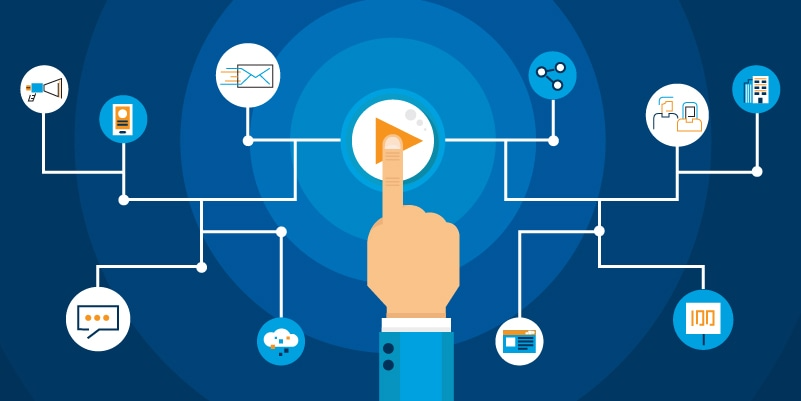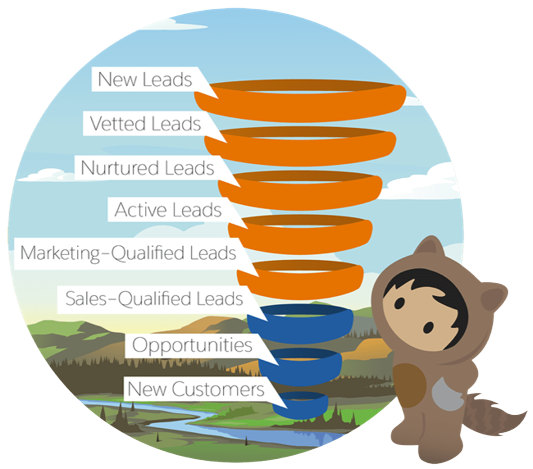What is Marketing Automation?
Nov. 8, 2022 · 8 minutes

Marketing automation is a software platform that helps you automate your marketing and sales engagement to generate more leads, close more deals, and accurately measure marketing success.
Marketing Automation Overview
Different types of companies, from SMB to enterprise, have their own way of finding new leads, nurturing them, and turning them into customers. However, like most solutions in a company’s martech stack, marketing automation platforms aren’t one-size-fits-all, especially in B2B.
In fact, because of the variation in buyer journeys across the B2B landscape, these platforms must be tailored to meet the needs of unique prospects — not to mention the distinct use cases of marketing and sales teams. B2B marketing automation platforms may have similar foundational components, but their implementation varies across different industries and brands.
Marketing automation helps B2B companies reach and engage prospects in many ways, including:
- Email marketing
- Social media marketing
- Lead nurturing and inbound marketing
- Digital advertising
- Landing pages and forms
Regardless of industry, channel, or use case, marketing automation platforms help B2B companies build personalized, seamless journeys for leads and customers at scale.
What Challenges Can Marketing Automation Solve?
Marketing and sales teams face many of the same challenges on a day-to-day basis. Here are a few examples of common challenges these teams face — and how to solve them with marketing automation.
Challenge #1
Your conversion rates are dropping, but your lead database is overflowing.
With lead scoring and grading, you can determine how engaged a prospect is based on activities like interacting with website content or emails. Plus, you can see how closely they match the profile of your ideal buyer. Lead scoring and grading features also make it easier to prioritize which leads to follow up with first.
Challenge #2
You're missing out on opportunities because your sales reps aren't connecting with buyers at the right time.
Powerful features like lead nurturing ensure that you won't miss out on an opportunity that isn't ready to close. For instance, prospects who aren’t ready to interact with sales teams can be automatically added to an educational email journey, which can deliver relevant, dynamic content based on their preferences.
Challenge #3
Sales and marketing goals are at opposite ends of the spectrum.
Sometimes, sales teams are left completely in the dark about how or if marketings efforts are impacting their bottom line. Working together, sales and marketing teams can clearly identify what an ideal lead looks like and create a process for sourcing, passing, and guiding leads through the sales funnel.

What Does Marketing Automation Actually Do?
Marketing automation primarily helps companies do one or more of the following:

Generate Leads
Lead generation is the process of collecting information about prospects — those who may be interested in buying your company’s products or services — and engaging them with relevant, useful marketing content, such as a step-by-step guide.

Manage Leads
Generating leads is just the beginning; managing them is a crucial step to drive interested leads through the marketing funnel until they’re ready to be passed off to sales teams. This step includes audience segmentation, lead qualification, and lead nurturing.

Build and Manage Email Marketing Campaigns
In B2B marketing, an effective email program can be the difference between closing more deals and letting hot leads slip through the cracks. You can build dynamic emails, use A/B testing to see which content works best, and set up triggers to automate email delivery at the right time.

Align Sales and Marketing Teams
Marketing automation can bring sales and marketing teams together to make their efforts more efficient and effective. Sales teams can deliver marketing-approved drip campaigns to leads, for instance, while marketing teams can see how their tactics contribute to increased sales via integration with CRM.

Report on ROI
Key stakeholders, such as CMOs, want to see marketing’s impact on revenue. Marketing automation platforms can help you check on the status of your funnel at a glance, report on campaign performance easily, and more.
Who Uses Marketing Automation?
Both marketing and sales teams use marketing automation. Although this technology brings the two together, marketing and sales teams actually use marketing automation in different ways.
Marketing automation for marketers
Marketers can use marketing automation to drive pipeline by sourcing the hottest leads, creating customized campaigns (such as email campaigns) to target ideal buyers, and moving leads through the sales cycle to maximize the ROI of marketing programs. Marketers can execute on a digital marketing strategy without all the hassle of sending one-off emails or managing tasks manually. They can also provide sales teams with pre-approved, on-brand messages (such as email templates) that sales teams can customize for qualified leads.
Marketing automation for sales
Marketing automation is the bridge that connects sales teams with marketers and gives them access to content they can send to leads with the click of a button.

Sales will know which leads to follow up with first and be able to focus their time on what matters most: closing deals.
Why use marketing automation?
Primarily, companies should use marketing automation to find and nurture leads, close more deals, and maximize ROI. But marketing automation is important for a number of other related reasons as wellle to focus their time on what matters most: closing deals.
By using it, you can do all of the following:
- Get a 360-degree view of prospect activity by linking data from your CRM to campaigns, which can help align sales and marketing teams.
- Easily identify and prioritize the hottest leads.
- Nurture cooler leads until they're sales-ready so you never miss an opportunity.
- Fill your pipeline with quality leads to directly impact revenue.
- Deliver personalized customer experiences across all channels and audiences.
- Target buyers at every stage of the buying cycle.
- Make data-driven decisions and identify new opportunities for growth.
How to Use Marketing Automation for Inbound Marketing?
Marketing automation and inbound marketing are not mutually exclusive; instead, marketing automation enhances your inbound marketing strategy. They are two pieces of the same puzzle that work in tandem.
But what exactly is inbound marketing?
Inbound marketing is the idea is that creating valuable content — such as whitepapers, infographics, e-books, blogs — helps extend reach to potential customers, engage them with targeted marketing efforts, and eventually lead them to conversion.
While inbound marketing is a great strategy for creating brand awareness, building relationships, and generating leads, it can fall short in a number of areas:
- Inbound is primarily a marketing tactic. By itself, it does not move prospects through the funnel. It’s less applicable to leads already in the sales funnel.
- Inbound doesn’t close deals (i.e., there’s not a huge sales component)
- Inbound requires a lot of content, so it may be daunting for many companies who don’t have time to build large content libraries.
- Inbound doesn’t necessarily result in qualified leads. It’s great at building awareness and capturing information initially, but lead qualification is lacking.
Marketing automation can bridge the gap in many of the areas where inbound falls short. For instance, marketing automation allows sales teams to be brought in to help close deals, which is something inbound marketing may not be fully equipped to accomplish on its own.

How to Use Marketing Automation for Account-Based Marketing (ABM)?
Marketing automation is vital to carrying out any account-based marketing strategy (ABM).
But what exactly is ABM?
ABM is a B2B marketing strategy that uses a suite of tools and processes to create personalized campaigns for target accounts. So, instead of a single campaign with many targets, you can create multiple campaigns, each targeting just one account.
There are four pillars for measuring success in ABM, and each of them involves marketing automation in some way.
1. Identify the right accounts
Use a predictive lead scoring solution to give you insights on which accounts are the highest-value prospects. You can also report on your existing customers to find trends to identify those target prospects.
2. Improve customer engagement
Use an artificial intelligence solution, such as Einstein Behavior Scoring, to analyze engagement data and determine which prospects are most likely to become customers in the future.
3. Align sales and marketing
Implement a unified platform to share sales and marketing data in one place.
4. Measure and optimize campaign performance
Track campaign performance and optimize content in real time across channels with a solution like B2B Marketing Analytics.
How to Get Started With Marketing Automation?
It might seem like a daunting task to get started with marketing automation — but not to worry.
Just answer the questions in these steps to start your marketing automation journey:
1. Determine the goal for your marketing efforts
- Are you focusing on generating leads and filling your sales pipeline?
- Are you trying to open up a new market?
- Are you focused on renewals and current accounts?
2. Look for use cases within your industry
- How has marketing automation worked for other similar businesses?
- How are they using a platform to meet their overall marketing goals?
3. Talk to your sales team
- What are their automation needs?
- How can they become more efficient?
- How can marketing better communicate with sales?
- Are there any gaps in your lead transfer processes?
4. Talk to your C-Suite
- What are the metrics that you should be using to track your performance and revenue goals?
- Are they different from the metrics you are using?
- Where do marketing's key performance indicators overlap with sales’ KPIs?
5. Think about your long-term goals
- Is your marketing automation platform adaptable and flexible?
- Can it grow and change as your business grows and changes?
References
- Pardot
Contact Us
Contact Info
Address
Maslak Mahallesi, Büyükdere Caddesi, Nurol Plaza 255 B02 Sarıyer, Istanbul, Turkiye
Phone